Si-o-se-pol
The Allahverdi Khan Bridge (Persian: پل اللهوردی خان), popularly known as Si-o-se-pol (Persian: سیوسهپل, lit. '[the] bridge of thirty-three [spans]'),[1] is the largest of the eleven historical bridges on the Zayanderud, the largest river of the Iranian Plateau, in Isfahan, Iran.[2]
Si-o-se-pol | |
|---|---|
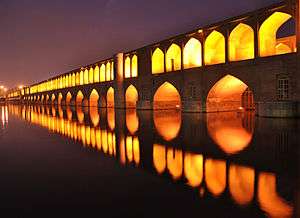 | |
| Coordinates | 32.6444°N 51.6675°E |
| Crosses | Zayanderud |
| Locale | Isfahan, Iran |
| Characteristics | |
| Design | Arch bridge, double-deck |
| Material | Stone and brick |
| Total length | 297.76 metres (976.9 ft) |
| Width | 14.75 metres (48.4 ft) |
| Longest span | 5.60 metres (18.4 ft) |
| No. of spans | 33 |
| History | |
| Construction start | 1599 |
| Construction end | 1602 |
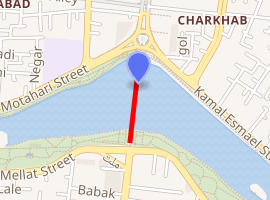
| |
The bridge was built in the early 17th century to serve as both a bridge and a dam.[3] It is a popular recreational gathering place, and is one of the most famous examples of Iran's Safavid architecture.
History
Si-o-se-pol was built between 1599 and 1602,[4] under the reign of Abbas I, the fifth Safavid king (shah) of Iran. It was constructed under the supervision of Allahverdi Khan Undiladze, the commander-in-chief of the armies, who was of Georgian origin, and was also named after him.[5] The bridge served particularly as a connection between the mansions of the elite, as well as a link to the city's vital Armenian neighborhood of New Julfa.[1]
 Panoramic photography of the bridge
Panoramic photography of the bridge
Structure
The bridge has a total length of 297.76 metres (976.9 ft) and a total width of 14.75 metres (48.4 ft). It is a vaulted arch bridge consisting of two superimposed rows of 33 arches, from whence its popular name of Si-o-se-pol comes, and is made of stone. The longest span is about 5.60 metres (18.4 ft).[4] The interior of Si-o-se-pol was originally decorated with paintings, which were often described by travelers as erotic.[1]
There is a larger base plank at the start of the bridge, under which the Zayanderud flows, supporting a tea house, which is nowadays abandoned.
Gallery
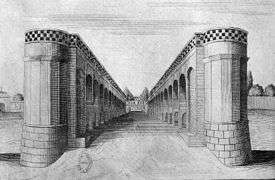 A 17th-century drawing of Si-o-se-pol by Jean Chardin.
A 17th-century drawing of Si-o-se-pol by Jean Chardin.- Benches and tables next to Si-o-se-pol.
- A view of the arches under Si-o-se-pol.
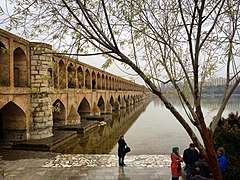 Si-o-se-pol in December 2015.
Si-o-se-pol in December 2015..jpg) Si-o-se-pol's view of the Zayanderud.
Si-o-se-pol's view of the Zayanderud.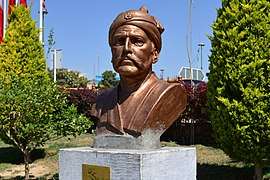 The statue of Allahverdi Khan, next to the bridge.
The statue of Allahverdi Khan, next to the bridge.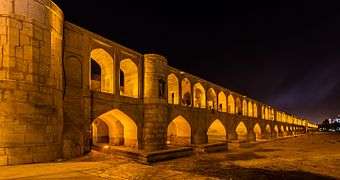 Si-o-se-pol at night.
Si-o-se-pol at night.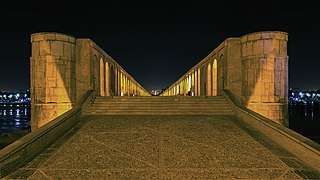 Si-o-se-pol's walkway at night.
Si-o-se-pol's walkway at night.
Transportation
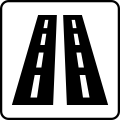







References
- Babaie, Sussan; Haug, Robert (5 April 2012) [15 December 2007]. "Isfahan x. Monuments (5) Bridges". In Yarshater, Ehsan (ed.). Encyclopædia Iranica. 1. XIV. New York City: Bibliotheca Persica Press. Retrieved 25 September 2015.
- Wagret, Paul (1977). Iran. Geneva: Nagel Publishers. p. 226. ISBN 2-8263-0026-1.
- "Drought poses no threat to Isfahan's Si-o-Se-Pol: official". Tehran Times. 25 December 2017.
- "Allahverdi Khan Bridge". Structurae. Retrieved 27 July 2018.
- Savory, Roger (2007). Iran Under the Safavids. Cambridge University Press. p. 170. ISBN 0521042518.
External links
| Wikimedia Commons has media related to Si-o-se Pol. |
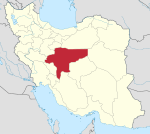
.jpg)